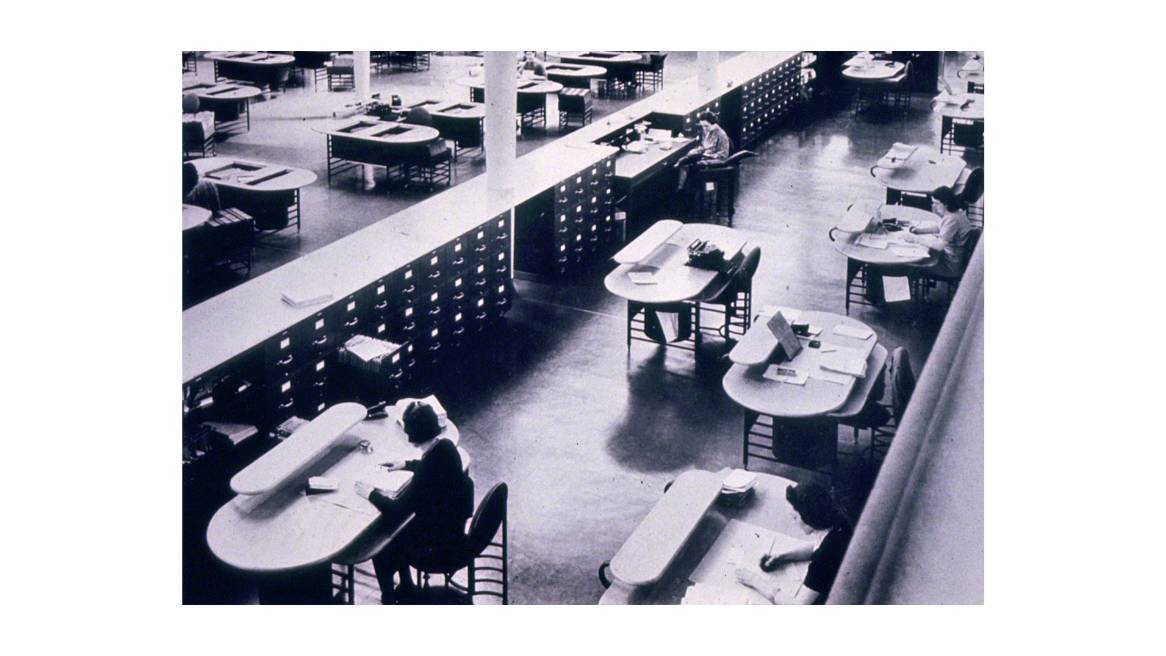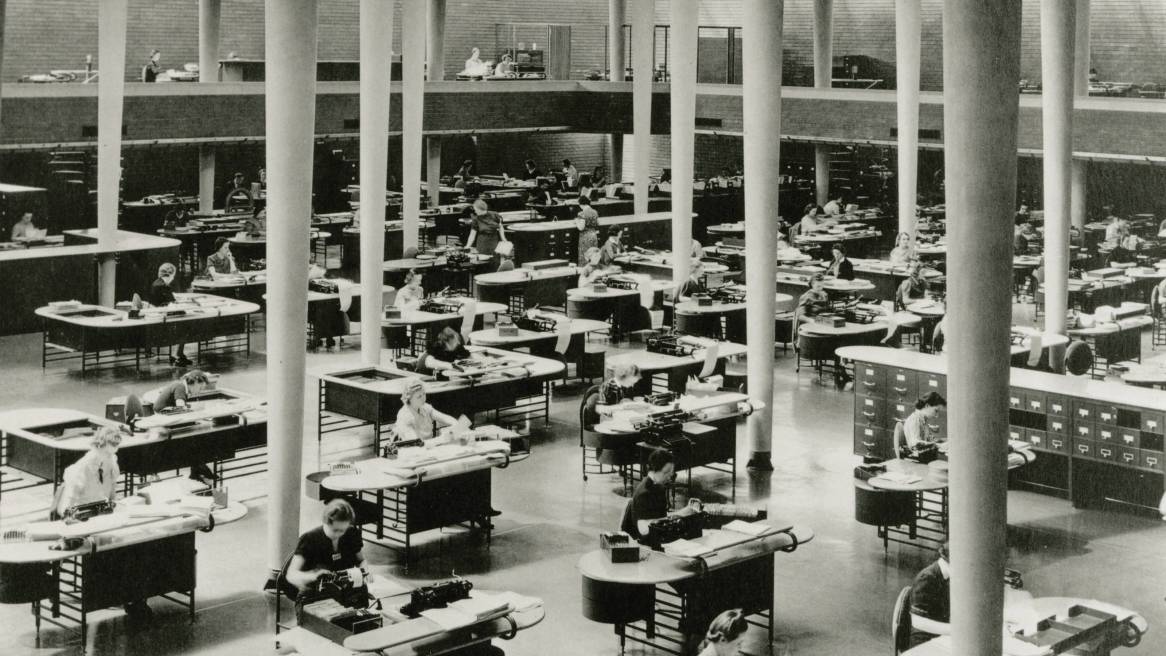The American Institute of Architects recognized Frank Lloyd Wright as “the greatest American architect of all time.” Now, 150 years after his birth in 1867, Wright’s legacy continues to influence generations of architects and designers. Steelcase proudly partnered with Wright in the late 1930s and continues to be inspired by his timeless architectural and furniture designs.
Johnson Wax Headquarters
David D. Hunting Sr., a Steelcase salesman and later a member of senior management, met Frank Lloyd Wright when Wright was working on the S.C. Johnson Wax Company headquarters in Racine, Wisconsin in the late 1930s. Their relationship lasted for years after their first meeting. Wright talked to Hunting about how he wanted the furniture in the space to fit the environment. He took a holistic approach to create a timeless design. The Metal Office Furniture Company, which would later become Steelcase, ended up engineering and manufacturing all of Wright’s furniture designs for the Johnson Wax building.

S.C. Johnson Wax
The S.C. Johnson Wax Administration Complex is a National Historic Landmark. When it was finished, Life magazine called it the greatest innovation since the skyscraper.
S.C. Johnson Wax
Wright designed the building without windows, but intended to “recreate nature” inside. Steel mesh-reinforced concrete, an innovation at the time, allowed him to build slender white columns to support the roof. Preserving the space continues to be a big part of the S.C. Johnson Wax culture today.
S.C. Johnson Wax
This iconic multilayer desk designed for S.C. Johnson Wax Company, and shown in what the company called The Great Workroom, is considered a forerunner of what would become the modern workstation.
S.C. Johnson Wax
Wright sketched his designs in pencil on tracing paper and then turned them over to engineers and manufacturers at Steelcase.
S.C. Johnson Wax
The desks and chairs were manufactured by The Metal Office Furniture Company, which would later become Steelcase.
S.C. Johnson Wax
This conference space included special tilting display easels designed with storage facilities concealed behind them.
S.C. Johnson Wax
In concert with the partnership with Wright, Steelcase created a portfolio that allowed everyone to see the furniture designed specifically for the S.C. Johnson Wax building.
S.C. Johnson Wax
As S.C. Johnson Wax grew, the building grew with it. Today, workers in the Great Workroom still work at the same desks. They now sit in Leap chairs from Steelcase. Daily tours of the Great Workroom let the public and students continue to learn from Wright’s legacy.
S.C. Johnson Wax
“Organic architecture designed this great building to be as inspiring a place to work as any cathedral ever was in which to worship.” - Frank Lloyd Wright, An Autobiography
Later in his life, Hunting Sr. said it was Wright’s approach to design that stayed with him.
“He (Wright) was always talking about not making an improvement, but solving the basic need in the best possible way. Starting from scratch instead of revising the already accepted thing. Most product improvement in our industry has just been that of modification and refinement. But, Wright said this approach did not bring the results as they should be. He would say, ‘Let me put my mind to it and I may come up with something entirely different and unheard of — but it will bring the needed result.’ I used this thought from then on,” Hunting Sr. said. He credited this idea to helping him as a manager develop future workplace concepts such as Multiple 15 which allowed for better office space planning.
Meyer May House
Decades after its first partnership with Wright, Steelcase had an opportunity to help restore a part of his legacy in its home state of Michigan. In 1985, Steelcase purchased and began the two-year process of refurbishing the Meyer May House in Grand Rapids to Wright’s original 1909 vision. Painstaking expert attention to hundreds of interior and exterior details help make it the most completely restored of Wright’s homes.

Meyer May House
David Hunting Sr. first suggested that Steelcase purchase and restore the Meyer May house. Robert C. Pew, then Steelcase chairman, agreed it was an excellent opportunity to pay homage to Wright and provide a gift to the public.
Meyer May House
Restoration of the property included cleaning and repairing more than 100 art glass windows and skylights.
Meyer May House
The Meyer May House opened to the public in 1987 and offers a rare opportunity to experience an original Prairie house as Wright envisioned it.
Meyer May House
People all over the United States had a chance to see Frank Lloyd Wright’s windows when Steelcase sponsored Light Screens: The Leaded Glass of Frank Lloyd Wright. The exhibition opened in New York City and showcased more than 50 of Wright’s windows. A national tour brought it to five other museums from 2001-2003.
Meyer May House
Designed for progressive and prominent clothier, Meyer May, the house changed significantly after it was built in 1909. At one point it was a multi-unit rental with carports and extra entrances.
Meyer May House
The interior of the home had to be completely recreated with original pieces and exacting reproductions. In some areas, six layers of paint were removed.
Meyer May House
To return the Meyer May house to its original condition, all of the plaster ceilings had to be replaced and the roof had to be rebuilt to restore its cantilevered design.
Meyer May House
Even the landscaping was included in the renovations. Meticulous research into Wright’s plans for the outside and inside of the property helped ensure the restoration preserved the house as Wright intended.
One-hundred-and-fifty years after he was born, Frank Lloyd Wright’s timeless approach to architecture and design still resonates. Just this year, the winner of the NEXT Student Design Competition sponsored by Steelcase said Wright’s Hollyhock House in Los Angeles inspired her winning entry.
Wright’s career stretched 70 years before he died in 1959. His passion for improving the world remains evident in the legacy he left behind.
“The mission of an architect is to help people understand how to make life more beautiful, the world a better one for living in, and to give reason, rhyme and meaning to life,” Wright said in 1957, according to the Frank Lloyd Wright Foundation.




